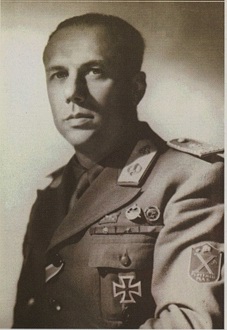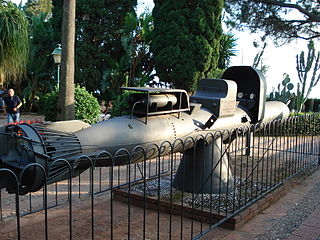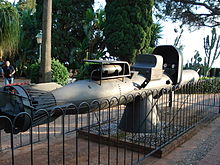
A frogman is someone who is trained in scuba diving or swimming underwater in a tactical capacity that includes military, and in some European countries, police work. Such personnel are also known by the more formal names of combat diver, combatant diver, or combat swimmer. The word frogman first arose in the stage name the "Fearless Frogman" of Paul Boyton in the 1870s and later was claimed by John Spence, an enlisted member of the U.S. Navy and member of the OSS Maritime Unit, to have been applied to him while he was training in a green waterproof suit.

A midget submarine is any submarine under 150 tons, typically operated by a crew of one or two but sometimes up to six or nine, with little or no on-board living accommodation. They normally work with mother ships, from which they are launched and recovered and which provide living accommodation for the crew and support staff.

Junio Valerio Scipione Ghezzo Marcantonio Maria Borghese, nicknamed The Black Prince, was an Italian Navy commander during the regime of Benito Mussolini's National Fascist Party and a prominent hardline neo-fascist politician in post-war Italy. In 1970, he took part in the planning of a neo-fascist coup, dubbed the Golpe Borghese, that was called off after the press discovered it; he subsequently fled to Spain and spent the last years of his life there.

The Decima Flottiglia MAS was an Italian flotilla, with marines and commando frogman unit, of the Regia Marina created during the Fascist regime.

Marquis Luigi Durand de la Penne was an Italian Navy admiral who served as naval diver in the Decima MAS during World War II. He was born in Genoa, where he also died.

Britain's commando frogman force is now the Special Boat Service (SBS), whose members are drawn largely from the Royal Marines. They perform various operations on land as well as in the water. Until the late 1990s, all members of the Special Air Service (SAS) Boat Troop were trained as commando frogmen.

COMSUBIN is the Italian Navy's special operations unit.

Above Us the Waves is a 1955 British war film about human torpedo and midget submarine attacks in Norwegian fjords against the German battleship Tirpitz. Directed by Ralph Thomas, it is based on two true-life attacks by British commando frogmen, first using Chariot manned torpedoes in Operation Title in 1942, and then X-Craft midget submarines in Operation Source in 1943. Filmed at Pinewood Studios, England, with outdoor scenes in Guernsey, some of the original war equipment was used in the film.

Teseo Tesei was an Italian naval officer, who invented the human torpedo used by the Regia Marina during World War II.

The Raid on Alexandria was carried out on 19 December 1941 by Italian Navy divers of the Decima Flottiglia MAS, who attacked and sank two Royal Navy battleships at their moorings and damaged an oil tanker and a destroyer in the harbour of Alexandria, Egypt, using manned torpedoes.

The Raid on Algiers took place on 11 December 1942, in the Algiers harbour. Italian manned torpedoes and commando frogmen from the Decima Flottiglia MAS were brought to Algiers aboard the Perla-class submarine Ambra. The participating commandos were captured after setting limpet mines which sank two Allied ships and damaged two more.

The auxiliary ship Olterra was a 5,000 ton Italian tanker scuttled by her own crew at Algeciras in the Bay of Gibraltar on 10 June 1940, after the entry of Italy in World War II. She was recovered in 1942 by a special unit of the Decima Flottiglia MAS to be used as an undercover base for manned torpedoes in order to attack Allied shipping at Gibraltar.

The CB class was a group of midget submarines built for the Italian Navy during World War II. However, they were also used by several other navies, seeing action in the Mediterranean and in the Black Sea.
The CA class were a group of midget submarines built for the Italian Navy during World War II.

Spartaco Schergat was an Italian military frogman during World War II.

The Chariot was a British manned torpedo used in World War II. The Chariot was inspired by the operations of Italian naval commandos, in particular the raid on 19 December 1941 by members of the Decima Flottiglia MAS who rode "Maiali" manned torpedoes into the port of Alexandria and there placed limpet mines on or near the battleships HMS Valiant and HMS Queen Elizabeth as well as an 8,000-ton tanker, causing serious damage which put both battleships out of operational use until 1943.

The Siluro San Bartolomeo was an Italian Human Torpedo designed during World War II, used by the Decima Flottiglia MAS for commando style operations. When using the Siluro a Lenta Corsa Maiale Human Torpedo had noticed some limitations, demonstrating the need for an updated version. The project was managed and developed by the engineer of the Genio Naval, Mayor Mario Masciulli, with the help of Captain G.N Travaglino and engineer Guido Cattaneo. The improvement in the materials available for the assembly and parallel new technologies led to a far superior product to the point of not being able to identify and as an outgrowth of the "Siluro a Lenta Corsa" SLC Maiale.

Mario Elbano Masciulli Manelli, Baron Miglianico was a prominent military engineer of the Italian Regia Marina, Major of Genio Navale and belonging to the recognized Decima Flottiglia MAS as director of the Office of Submarine Secret Weapons during Second World War. He was awarded the Silver Medal of Military Valor.

Naval Special Forces Command, also called the Kampfschwimmer or Verwendungsgruppe 3402 are an elite special forces unit of the German Navy, specializing in commando and amphibious warfare operations. They are the only special-purpose force of the German Navy. The Kampfschwimmer were set up when West Germany joined NATO in 1955.

Vittorio Moccagatta was an Italian naval officer during World War II. He commanded the Decima Flottiglia MAS, the special operations unit of the Royal Italian Navy, from September 1940 until his death in action on 26 July 1941.










![A SLC, or "Maiale", exhibited in the Museo Sacrario delle Bandiere [it] delle Forze Armate, in Rome, Italy Maiale SLC.jpg](http://upload.wikimedia.org/wikipedia/commons/thumb/c/cb/Maiale_SLC.jpg/220px-Maiale_SLC.jpg)


















